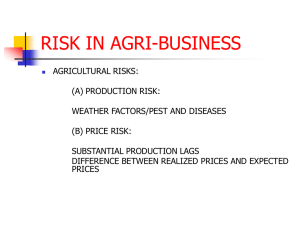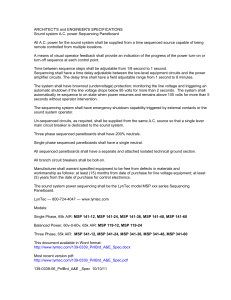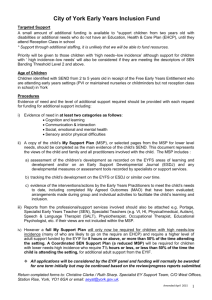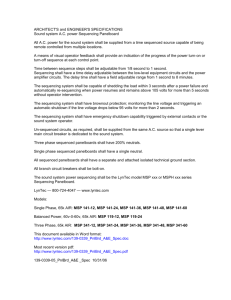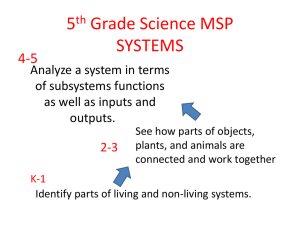The added value of Marine Spatial Planning (MSP) - UNESCO
advertisement
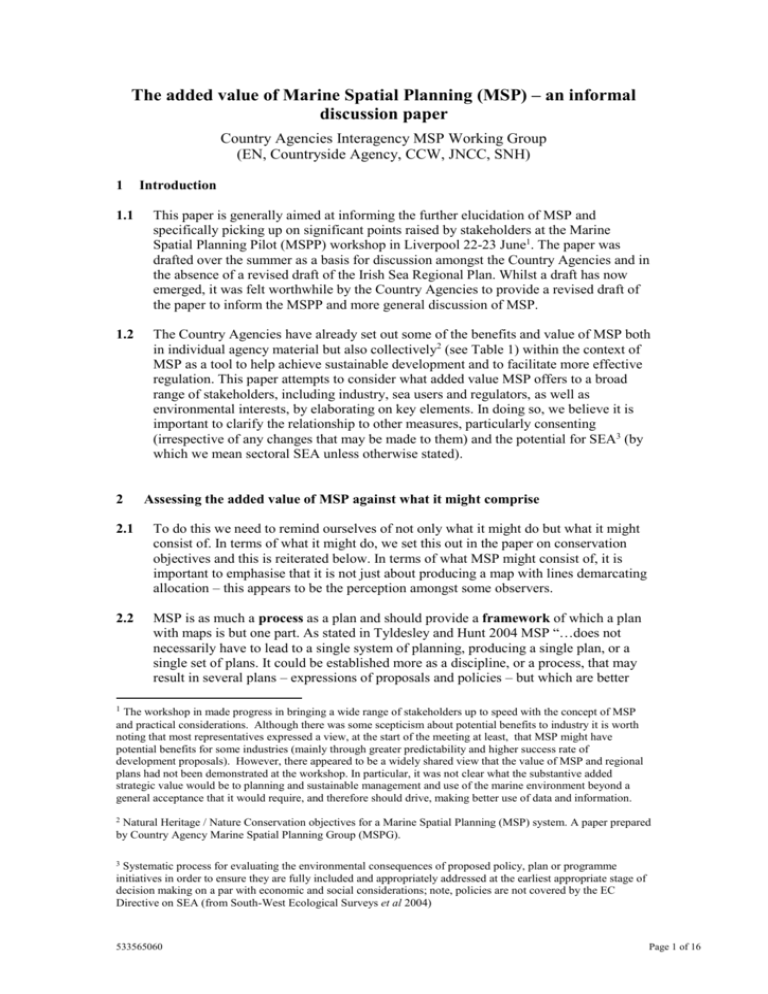
The added value of Marine Spatial Planning (MSP) – an informal discussion paper Country Agencies Interagency MSP Working Group (EN, Countryside Agency, CCW, JNCC, SNH) 1 Introduction 1.1 This paper is generally aimed at informing the further elucidation of MSP and specifically picking up on significant points raised by stakeholders at the Marine Spatial Planning Pilot (MSPP) workshop in Liverpool 22-23 June1. The paper was drafted over the summer as a basis for discussion amongst the Country Agencies and in the absence of a revised draft of the Irish Sea Regional Plan. Whilst a draft has now emerged, it was felt worthwhile by the Country Agencies to provide a revised draft of the paper to inform the MSPP and more general discussion of MSP. 1.2 The Country Agencies have already set out some of the benefits and value of MSP both in individual agency material but also collectively2 (see Table 1) within the context of MSP as a tool to help achieve sustainable development and to facilitate more effective regulation. This paper attempts to consider what added value MSP offers to a broad range of stakeholders, including industry, sea users and regulators, as well as environmental interests, by elaborating on key elements. In doing so, we believe it is important to clarify the relationship to other measures, particularly consenting (irrespective of any changes that may be made to them) and the potential for SEA3 (by which we mean sectoral SEA unless otherwise stated). 2 Assessing the added value of MSP against what it might comprise 2.1 To do this we need to remind ourselves of not only what it might do but what it might consist of. In terms of what it might do, we set this out in the paper on conservation objectives and this is reiterated below. In terms of what MSP might consist of, it is important to emphasise that it is not just about producing a map with lines demarcating allocation – this appears to be the perception amongst some observers. 2.2 MSP is as much a process as a plan and should provide a framework of which a plan with maps is but one part. As stated in Tyldesley and Hunt 2004 MSP “…does not necessarily have to lead to a single system of planning, producing a single plan, or a single set of plans. It could be established more as a discipline, or a process, that may result in several plans – expressions of proposals and policies – but which are better 1 The workshop in made progress in bringing a wide range of stakeholders up to speed with the concept of MSP and practical considerations. Although there was some scepticism about potential benefits to industry it is worth noting that most representatives expressed a view, at the start of the meeting at least, that MSP might have potential benefits for some industries (mainly through greater predictability and higher success rate of development proposals). However, there appeared to be a widely shared view that the value of MSP and regional plans had not been demonstrated at the workshop. In particular, it was not clear what the substantive added strategic value would be to planning and sustainable management and use of the marine environment beyond a general acceptance that it would require, and therefore should drive, making better use of data and information. 2 Natural Heritage / Nature Conservation objectives for a Marine Spatial Planning (MSP) system. A paper prepared by Country Agency Marine Spatial Planning Group (MSPG). 3 Systematic process for evaluating the environmental consequences of proposed policy, plan or programme initiatives in order to ensure they are fully included and appropriately addressed at the earliest appropriate stage of decision making on a par with economic and social considerations; note, policies are not covered by the EC Directive on SEA (from South-West Ecological Surveys et al 2004) 533565060 Page 1 of 16 integrated and their spatial implications are better understood and co-ordinated”. The evolution of the land use planning system (see, for example, analysis in Tyldesley and Hunt 2004 and Tyldesley 2005), indicate that MSP could include a number of elements: National planning policy guidance in association with principles, sectoral policy guidance and national objectives At a regional or local level a number of documents that amount to a spatial planning strategy including: o Core strategy, ie integrated view of implications of different objectives and guidance o Spatial assessment based on collated data o Management measures such as mitigation, planning conditions or ‘Action Plans’ focussed on particular areas o Indicative allocations o Prescribed allocations o Comprehensive zoning scheme, ie entire planning area assigned to zones 2.3 Thus there are a number of elements to MSP without proceeding as far as a comprehensive zoning scheme. It is also clear that there is no prerequisite for MSP to proceed as far as prescribed spatial allocations4, it might instead simply indicate preferences or priorities (such ‘indicative planning’ would not prevent users from applying to use other areas including an area indicatively allocated to another use). Equally, zoning may not need to apply across the whole plan area in the sense that specific ‘zones’ might be identified, eg a conservation priority zone, amongst one general ‘zone’ that covers most of the area. 2.4 It is important to recognise that the different elements and their benefits can be achieved without going as far as a comprehensive zoning scheme with prescribed allocations, ie MSP is not “all of the above or nothing”. This point is indicated conceptually in Figure 1 in general terms, ie without reference to any particular sector or organisation. A key question is at what point do those involved (those making decisions, those advising on them and those affected by decisions) believe the benefits are outweighed by the disbenefits. We suggest that the value of MSP is additive with each new element, rather than the value only arising from a combination of all elements. We recommend that proceeding as far as assigning the equivalent of “development rights” would be a disbenefit and that, at present, a partial element of prescribed allocation is the furthest point at which maximum benefits can be derived. 2.5 In view of the above, and to better indicate what MSP is about, we suggest it might be appropriate to adopt (or re-adopt) the term “Sea Use Planning”. 3 3.1 Assessing the added value of MSP against alternatives The view that MSP doesn’t appear to add to what we have already have (based on what was presented at the Liverpool workshop) seemed to be made against the background of current consenting regimes and associated EIA and, for some sectors, SEA. Each of these has its use and advantages (see, for example, Gilliland et al 2004), the question is what can MSP offer that EIA and SEA can’t. A number of added benefits have been It is assumed that no one is advocating proceeding as far as the equivalent of ‘permitted development rights’ and that even assigned allocations would be subject to further detailed EIA (the scope of which may depend on what information and decisions have determined the allocation) 4 533565060 Page 2 of 16 proposed in various documents but these are reiterated or noted in Table 2 with suggested comments about what could be achieved in the absence of MSP. 3.2 4 Sections 4 and 5 elaborate on the added value that arises from objective setting and spatial analysis within an MSP framework. A framework for setting objectives 4.1 Purpose: MSP should have an overall purpose and objectives which we believe should be focussed on achieving sustainable development, rather than simply conservation or environmental protection, and in doing so contribute to more general government objectives. We believe it is helpful to emphasise the following in defining the specific purpose of marine spatial planning: to provide a strategic, integrated and forward-looking framework for all uses of the sea to help achieve sustainable development, taking account of environmental as well as social and economic objectives; to apply an ecosystem approach to the regulation and management of development and activities in the marine environment by safeguarding ecological processes and overall resilience to ensure the environment has the capacity to support social and economic benefits (including those benefits derived directly from ecosystems); to allocate space in a rational manner which avoids or minimises conflicts of interest and, where possible, maximises synergy between sectors; to identify, safeguard, or where necessary and appropriate, recover or restore important components of coastal and marine ecosystems including natural heritage and nature conservation resources. 4.2 Added value: Whether one agrees with the suggested purpose, there is added value in defining a purpose rather than, as currently, simply defining each sector’s needs and hoping that these needs can be integrated or reconciled in the absence of some overall ‘top down’ direction. Improved coordination of data gathering, management and greater accessibility of datasets will have obvious benefits to both statutory agencies and developers. 4.3 Objectives: Within the overall purpose, MSP should provide a framework within which to articulate, reconcile, optimise and integrate relevant economic, environmental and social objectives collectively; this was a shortcoming in the Liverpool simulation where there was almost no reference to government policy and objectives. As far as we are aware, this is not done at present in the marine environment or under the auspices of any existing measures. Objectives, with associated targets, are defined for some individual sectors, either explicitly, eg the 10% by 2010 target for renewable energy, quotas for fisheries, or implicitly, eg to optimise exploitation of oil and gas reserves wherever they are found. 4.4 Even then, objectives do not seem to be broken down into more operational regional targets and rarely do they have a spatial context, although again these are sometimes implicit, eg much of the sand and gravel for regeneration of east London will come from marine sources (primarily from the Outer Thames and English Channel) because of direct transport provision to wharves in London. Thus, an MSP that includes a regional level provides a framework within which to identify and state the contribution that will be made by the area covered by the plan, ie ‘region’, to national objectives, 533565060 Page 3 of 16 such as wind and other renewable energy targets to be achieved, fish stocks in need of recovery, Habitat Action Plan targets. 4.5 Added value: Defining overall purpose/objectives and then more detailed objectives that ideally are spatially defined, including for different sectors of human use, should provide the following added value compared to existing measures or other planned measures: A clear, albeit ‘top down’, driver for what is to be achieved within the MSP area to complement ‘bottom up’ stakeholder input, strengthening the vertical integration between national policy guidance and targets and the regional delivery of these (some observers have suggested this is the element that has been missing from achieving successful Estuary Management Planning in some cases) A better basis on which to consider the inter-relationship between economic, environmental and social objectives at the same time, rather than sequentially, and increase the chances of achieving sustainable development; Provide a more strategic basis for any one economic sector to identify the objectives of other sectors, and for the environment and social aspects, with which they may interact and take account of these, for example to reduce conflicts and encourage synergies. This should reduce the burden on any one sector for undertaking this analysis, eg through their sectoral SEA Better basis for identifying widely agreed, common scenarios for the future taking account of the best available forecasts such as identifying which targets are likely to change significantly beyond the 20-year planning time frame (eg renewable energy targets?) and their projected increases. It is accepted that the ability to forecast will vary between sectors. For example, aggregate production and energy generation can be directly linked to development, such as housing needs (see regeneration of east London example above) whereas there may be gas reserves that have yet to be discovered, fisheries exploit a resource that moves over space and time and the distribution of wildlife can change. These differences would need to be accommodated irrespective of the management measure under consideration. Proactive approach to the delivery of objectives for the safeguard and recovery of the marine ecosystem and the services that it provides rather than through each sector of economic activity having to enter into consultation on these for every development application Improved governance with greater confidence of government, industry and others of how and where their objectives can and should be translated into delivery at the regional/local level. 4.6 SEA: SEA is not an objective setting process but rather is driven by objectives already identified. Hitherto, and in the near future, SEA in the marine environment is being applied sectorally. Thus the SEA is driven by the objectives for that sector only, making it difficult to take account of and reconcile objectives for other sectors of use. SEA, for oil and gas at least, does identify the ‘constraints’ that result from current development/use and conflict with environmental concerns but it is limited in its ability to address conflict based on future scenarios for other sectors. Undertaking SEAs from the perspective of different sectoral interests, for example aggregates, windfarms, oil & gas, also has cost implications, with the potential for savings if the process is better integrated with the framework of MSP. 4.7 Consenting: Clearly a close link between objectives identified by a sector (or for a particular development) with national or regional policy guidance should inform consent decisions. MSP would strengthen this by providing a framework for articulating objectives up front (and providing some spatial expression of these – see Section 5), MSP could ensure such objectives are more clearly set out, more integrated 533565060 Page 4 of 16 and better understood than at present and therefore ensure the relevance of objectives to consent decisions is made more transparent, including where they are subject to some form of Public Inquiry. 5 Spatially expressing objectives and zoning 5.1 It is recognised from the above that benefits can be derived from the planning process without producing maps, such as better understanding of different sectors’ aspirations. However, spatial analysis and interpretation using maps would seem an obvious additional beneficial part of the planning process (analogous to the Regional Spatial Strategies and Local Plans). For instance, most sectors at sea use a definable space, albeit over varying periods of time, and it is therefore possible to express spatially the objectives for each sector. There appears to be a widely shared view that it is logical to have some form of spatial expression of objectives, not least to improve visualisation of the complex array of sea-use interactions. Such spatial analysis will involve a number of steps (see Figure 2) each of which would be beneficial; we believe that it is essential in the MSPP to elaborate as much as possible on such spatial analysis and clarify the role and value of each step. 5.2 The MSP process should consider the degree to which objectives, targets and uses are inherently spatially or temporally constrained. There are different constraints a) Location of the resource5 b) Co-location of incompatible uses or interest c) A decision to constrain a use through policy or regulation 5.3 In relation to 5.2a), some objectives and targets will only relate to a small part of the MSP area – for example, targets for the exploitation of marine aggregates would only be constrained to within areas of suitable deposits. The greater the degree of this spatial constraint the less flexibility there is likely to be to adjust ‘use’ boundaries between conflicting uses, for example. It would seem useful to identify and map the objectives/targets and actual/potential uses using the approach in Table 3. This should enable the mapping of targets by high and moderate spatially constrained categories. 5.4 Having undertaken the analysis described in 5.3 MSP, using GIS as a key tool, provides a framework to assess the interaction between uses and associated objectives/targets, including to: i) ii) iii) iv) 5.5 interrogate different ‘layers’ to identify where and to what extent targets and actual/potential uses overlap, including sensitivity of the environment to particular uses or of a use to other uses assess the interactions between uses and objectives/targets (positive or negative, large or small, short, medium or long term) assess the extent of interactions between highly (and moderately) spatially constrained targets/uses identify where there are potential conflicts which may prevent targets being achieved This assessment should provide a basis to assess the potential for integrating uses and associated objectives/targets, including the following categories: 5 Based on up to date information on the distribution of the resource and what is technically possible. New resources may be found but equally technological development may make currently unexploitable resources available. 533565060 Page 5 of 16 i) ii) Area where targets/uses are likely to be compatible, complementary or synergistic Areas where interests may conflict and where specific measures are likely to be required. There are a range of options which should be considered through further assessment, including to better understand the nature and degree of conflict, rather than simply assuming there is a need to separate uses or allocate areas (see Figure 2). Such assessment could lead to the following categories a. Management, mitigation or other measures to meet sustainable development objectives b. Identify areas where priority should be given to one or more targets/uses, subject to their meeting sustainable development considerations, ie indicative or preferred allocation. c. Identify areas where exclusive use may need to be given to a particular target/use, ie prescribed allocation. 5.6 In relation to 5.5ii) b) and c), the spatial expression of such allocation would be ‘zones’. Even where spatial or temporal separation of uses are required, more detailed assessment or investigation could inform this, eg are there opportunities to adjust the spatial distribution of moderately restricted uses and targets around highly restricted uses? 5.7 It should be possible, and of value, to map the output of this assessment. It is easier to envisage examples based mainly on current use (see Table 4, Areas 1-4). It should be noted that such examples already occur in the Irish Sea, ie areas already being used, often subject to multiple-use, some of them subject to licence conditions. Other examples would include where policies or priorities are indicated (see Areas 5 and 6, Table 4). Current use and priorities have to be factored into the spatial assessment (see Boyes et al 2005 for further examples). 5.8 A key question is the extent to which the spatial element of MSP can look forwards and how prescriptive it can be. This, of course, will be largely determined by the government policy and objectives that drive MSP. It is likely that the ability of MSP to forward plan spatial allocations should increase as the MSP process, and practical experience with it, develops. The extent to which MSP needs to be prescriptive is likely to depend upon an assessment of the need (and ability) to make spatial allocations for agreed, specific, high priority uses, to ensure that those uses and targets associated with them, are not compromised by others. We suggest that added value will be derived from clarifying existing allocations, expressing policies/conditions/limitations spatially, indicating preferences for future use and perhaps going as far as a partial element of prescribed allocation (see 2.4). 5.9 As stated above, where some form of spatial separation (which may have a temporal element), preference, exclusion or allocation has been decided on, such areas would be termed ‘zones’. It is a separate step as to whether to integrate and summarise all such zones in the form of a comprehensive zoning scheme for part or all of the area under consideration (it is not axiomatic that the whole area is divided into zones). Different case studies have identified different integrated ‘zones’. For example, Boyes et al 2005 have undertaken a similar categorisation based upon an analysis of existing activities in the Irish Sea (reflected in the latest version of the draft plan for the Irish Sea). Table 5 includes examples of some suggested integrated zones that might encompass future as well as current use but the efficacy of such an approach requires further examination. 6 Conclusion 533565060 Page 6 of 16 6.1 From the above, the added value of MSP compared to current governance tools such as consenting informed by EIA and SEA is: 1. Process and framework for identifying environmental, economic and social objectives collectively and objectives across different sectors at both national and regional level. 2. Process for identifying or considering priorities. 3. Basis for assessing the spatial implications of objectives and targets and interactions between sectors of use and between all sectors and the environment in a more comprehensive and (net) efficient way than sectorally. 4. Process and framework for considering options to achieve objectives and, where these can’t all be achieved, for making choices between them, and presenting the outcome of such analysis or decisions. 5. More strategic and efficient approach to data management with informed view of priorities for data collection and potential value for money if value of data across objectives/sectors is factored into setting priorities. 6. Improved governance though better basis for democratic accountability involving all sectors and increased potential for involvement of local and regional interests. 7. Better basis (particularly in relation to 6) to provide commonly understood and accessible information and scenarios. 6.2 A number of disbenefits to MSP have been suggested including the fact that it will not reduce significantly the amount of effort and resources required for EIA. However, such disbenefits or limitations also apply to SEA. At present, it is difficult to fully articulate the benefits of MSP without a clear view of how current consenting regimes will be changed by primary legislation and how MSP might therefore, replace current regulatory regimes that are overlapping and overly complex. 6.3 Comparison with SEA: The benefits of MSP vs sectoral SEA are discussed above (see also Table 2). If, as some suggest, we could undertake a ‘super SEA’ rather than sectoral SEA, compared with 6.1 above, then point 5 in large part and 3,4, 6 and 7 in some part might be achieved. Indeed, the process for MSP and SEA are very similar (see Figure 3). The key difference with a ‘super SEA’ is that the SEA process does not generate objectives and is not required to address objectives of different sectors, proactively address environmental and social objectives, and assess their interaction or how to reconcile or choose between them. 6.4 Ideally, a spatial plan would be produced, subject to SEA and this would then provide a context for any further, sectoral SEA if required. In reality, in the short to medium term MSP needs to build on sectoral SEAs already undertaken. MSP will take several years to establish and in the meantime much could be achieved by undertaking SEA of particular sectors, such as those completed for the hydrocarbon and renewable energy sectors and those that may be undertaken for sectors such as fisheries, which would facilitate the development of a spatial planning system. In the longer term, a MSP framework accompanied by SEA should reduce both the need and amount of effort to undertake sectoral SEAs. 6.5 Comparison with consenting and EIA: EIA is always likely to be at a finer scale of resolution than MSP (and SEA). It should be the case that MSP as envisaged above should provide a better context in which to assess, for example, the impact of an individual development on a particular environmental feature or the impact of one type of development on other types of development. It is not clear why some protagonists expect MSP to substantially reduce the amount of effort required for EIA, and even to expect that MSP do so more than SEA. 533565060 Page 7 of 16 6.6 The benefits that MSP should bring to EIA and consenting, and to industry and regulators includes: Clearer framework of policy, objectives and priorities Some up front indication of the views of regulators, their advisers and other industries A better basis for setting their development in the context of the broader area, including reduced effort and onus on an individual applicant or sector to fund and undertaken collation or collection of data on the broader area Reduced effort and onus on an individual applicant or sector to fund and undertaken assessment of cumulative effects Increased potential for sharing costs of monitoring Some indication of more or less ‘difficult’ (or more ‘sensitive’) sites and therefore a better basis on which to judge whether to pursue a particular location. This will not necessarily change at all the requirements of the consenting process but it should bring efficiencies by reducing the number of contentious and costly (to regulators and their advisers as well as industry) applications entering the consenting process. References BOYES,S., ELLIOTT, M., THOMPSON, S., ATKINS, S., GILLILAND, P., HAMER, J. & HILL, A. 2005. Multiple-use zoning in UK and Manx Waters of the Irish Sea: interpretation of current legislation through the use of GIS-based zoning approaches. Report to Scottish Natural Heritage, English Nature and Countryside Council for Wales. Scottish Natural Heritage, Perth. DEPARTMENT FOR TRADE AND INDUSTRY. 2002. Future offshore: a strategic framework for the offshore wind industry. London: Department for Trade and Industry. EAST OF ENGLAND REGIONAL ASSEMBLY. 2005. East of England Plan (Regional Spatial Strategy 14 ), Consultation version. GILLILAND, P.M., ROGERS, S., HAMER, J.P., & CRUTCHFIELD, Z. 2004. The practical implementation of marine spatial planning – understanding and addressing cumulative effects. Report of a workshop held 4 December 2003, Stansted. English Nature Research Reports, No. 599. POSFORD HASKONING LTD, DAVID TYLDESLEY ASSOCIATES, THE CENTRE FOR THE ENVIRONMENT, FISHERIES AND AQUATIC SCIENCES, HR WALLINGFORD LTD. 2004. A development plan for marine aggregate extraction in England. A scoping study. London: Office of the Deputy Prime Minister. TYLDESLEY, D. 2005. Integrated Coastal Zone Management and the Planning System in England. English Nature Research Report 643, English Nature Peterborough. TYLDESLEY, D & HUNT, B. 2004. Review of how the Land Use Planning System could influence the development of a Marine Spatial Planning System for England. Peterborough: English Nature Research Reports, No. 566. 533565060 Page 8 of 16 Table 1. The potential benefits of marine spatial planning (from recent Country Agency paper) Benefits for nature conservation It promotes efficient use of space and resources, in a way that reduces impacts on the environment. It ensures there is space for biodiversity and nature conservation measures and places biodiversity commitments at the heart of planning and management. It provides a proactive and focused way to achieve nature conservation objectives. It establishes areas of importance or sensitivity, thereby reducing the risk of conflict with incompatible development. It provides a broad framework within which to understand and maximise the value of a network of multiple-use sites and highly protected marine areas. It offers a key tool to pre-empt or address cumulative effects on the natural environment. It improves prospects of increased awareness and ownership of marine conservation features and issues, particularly amongst users, regulators and decision-makers. Wider benefits to industry and other users It allows greater confidence for industry when planning new development and a reduction in conflict between competing users. It provides for rational allocation of space in the marine environment that will help to deliver a strategic vision for UK seas in accordance with government priorities 533565060 Page 9 of 16 Table 2. Potential added value of different elements of MSP Aspect MSP Without MSP (including EIA/SEA) Strategic direction national National planning policy guidance driven by overall vision of what is desired for the marine environment Strategic objectives across sectors - national Provides a process and framework, because it is cross-sectoral, to encourage and set out clear objectives. Based on this, provide forecasts, as far as possible, to inform planning and planning policy guidance An overall Vision expressed as the desired state doesn’t require an MSP but it is not clear how other mechanisms could proactively encompass this beyond “the consenting body should take account of this” Individual sectors have had objectives identified for them in some way, eg the broad target of 10% of energy supply by 2010 from renewables (accompanied by an assessment of the potential of the marine renewables sector in DTI 2002) and for aggregate extraction in Posford Haskoning et al 2004. However, it is not clear that this will be done for all relevant sectors on an individual basis as quickly or readily than if all sectors were required to do so as part of a more integrated approach. SEA essentially considers environmental objectives ‘reactively’. Individual sectors do try to set out regional objectives and targets, eg through Regional Aggregate Working Parties (although it is not clear whether this has been in the context of POSFORD HASKONING ET AL 2004). DTI advocated the need for a regional breakdown of the national target for renewable energy generation in the wake of Future Offshore (DTI 2002) and regional targets have appeared in Regional Spatial Strategies (see East of England Regional Assembly 2005). However, it is not clear that this will be done for all relevant sectors on an individual basis as quickly or readily than if all sectors were required to do so as part of a more integrated approach. Provide a framework for enhanced working between government departments. Strategic direction and objectives regional Provide a process and framework to consider the contribution the region can or needs to make to national objectives (and possibly a better a basis for considering these together than at the national level) now and in the future taking account of likely significant changes over the period of the planning cycle. Provide early indication of relevant objectives and concerns, eg environmental objectives. “A commitment to Marine Spatial Planning might give better focus and impetus [than EIA or SEA) to tackle long standing issues such as providing environmental objectives at a broad scale…” (Gilliland et al 2004). Provide a process and criteria by which priorities could be set and, therefore, part of the basis for resolving conflicts, ie making choices between uses Assess spatial implications of objectives 533565060 Provide a framework to do so across all sectors including not only the current pattern of use but realistic scenarios that take account of all sectors. Able to consider sectors with different spatial A process is underway to identify marine ecosystem objectives. The JNCC Irish Sea Pilot produced some draft conservation objectives at a regional scale. It is open to question whether there would be sufficient focus and impetus to derive regional environmental objectives without a crosssectoral governance mechanism such as MSP. Appear to be no (transparent) alternatives to identify priorities Any SEA and even EIA can map the current pattern of use although if this is repeated for each assessment it is less efficient than being done as one collective effort under MSP. Future use has been Page 10 of 16 restrictions. By proactively including environmental objectives, provides a better basis for identifying upfront areas of importance or sensitivity to, eg, industry, rather these being identified reactively during an EIA or SEA assessed for individual sectors, eg high, medium and low development scenarios in BMT Cordah (wind SEA), but it is difficult for such sectoral driven assessments to take account of other sectors’ scenarios. Potential to co-ordinate and mediate between regulation/regulators, including information, without developers having to go to each of them Assess interactions between different uses and between these and the environment Consider options for addressing outcome of interactions including conflicts Provide a framework for enhanced working between government departments. Provide both a process and framework to better assess (including collectively and more efficiently) interactions than if being done by one sector/developer/regulator. Provide more comprehensive analysis of where real issues are. Enable opportunities through complementary and synergistic uses to be identified. Provides a better basis to assess and make decisions about cumulative and in combination effects over a broad area Provides a process and framework for identifying options that maximise opportunities, eg optimising use of space by identifying compatible uses in the same area, and addressing conflicts, eg referring back to priorities and ‘decision rules’ “we can achieve 85% of target for sector X if accept only 60% of target for sector Y”. Sectoral tools will only assess the interaction between that sector and other sectors and therefore give an incomplete picture. They tend to focus on conflicts rather than opportunities. EIA, SEA and MSP are complementary ‘tools’ to assess cumulative effects and as one moves from the former to the latter the ability to assess cumulative effects becomes more complex and uncertain (Gilliland et al 2004). However, it is more difficult for an individual sector to identify and assess cumulative effects compared to the cross-sectoral approach of MSP Can only assess options from perspective of one sector or developer. May identify options that raise other conflicts for other sectors or elsewhere in the region depending on the scale of the area being assessed. Enables different permutations of options to be explored and their relative merits assessed (in conjunction with different users). Data management (collation, interpretation, collection) 533565060 Provides a transparent framework to indicate locational guidance, priorities or even allocations in zones across all of or part of the area. Potential to provide a more strategic and efficient approach to data management. “Participants thought that a commitment to Marine Spatial Planning could drive a more strategic and comprehensive approach to managing data for the marine environment ..” and “give a better focus The oil and gas SEA in particular has undertaken substantial data management, albeit from the perspective of one industry; this provides a good basis to build on. However, experience with offshore wind and aggregates demonstrates both the difficulty and unfeasibly high cost of data management for individual sectors let alone Page 11 of 16 and impetus to tackle long standing issues such as ….addressing prioritised data gaps that haven’t been tackled solely in response to assessing cumulative effects.” Gilliland et al 2004. Democratic accountability It would seem to be an advantage to individual industries or regulators if data management for an area, eg at the scale of wind or oil & gas SEA, was not left to them to undertake or fund, and sometimes repeated, ie MSP increases the chances of data management attracting strategic funding and co-ordination. Compared to the current situation, MSP provides a process by which analysis and the basis for decisions is undertaken in ‘public’ using common scenarios informed by a common and more comprehensive (compared to that collected for one sector) data set. developers. The Marine Data Information Partnership is evaluating how to achieve more effective data/information management (gathering, collation, access etc) but is currently focussed on issues such as sharing of data, and providing commonly accessible resources, such as bathymetry, rather than collation and collection of all data for a region. ODPM’s draft EIA Regulations for marine minerals may provide for public inquiry where appropriate Both EIA and SEA have well established consultation processes and mechanisms, eg steering group for oil and gas SEA with wide membership. MSP could increase the opportunity for ‘public’ or ‘users’ to comment compared with current arrangements, eg a ‘right to be heard’? Table 3. Categories of activity by degree of spatial restriction of resource and its potential use Category Activities with a high spatial restriction Activities with a moderate spatial restriction Activities with a low spatial restriction 533565060 Description The resource and potential use of it is restricted to a small and specific areas of the MSP area (examples might include: marine aggregates, oil and gas, tidal energy, protected wrecks, nationally important habitats) The resource and potential use of it is more widespread and there may be greater flexibility in spatial allocation to minimise conflict and optimise benefits (examples might include offshore wind energy, landscape scale nature conservation, some fisheries) Resources and uses which are extensive within the MSP area and for which there may be limited flexibility to move location but more flexibility on the measures available to minimise conflict with other uses (examples might include objectives relating to navigation, recreational sailing, conservation of mobile species, wider environment) Page 12 of 16 Table 4. Hypothetical examples of areas in the different categories identified by spatial analysis (refer to section 5.7) CURRENT USE Category i) ‘compatible, complementary or synergistic’ Area 1: no current conflict between uses, with only interest (occurring already) being aggregate extraction. Conditions of licence include….. Area 2: current uses compatible (conservation management, navigation, and submarine cables) and no identified additional future use Category ii) a) ‘Management, mitigation or other measures’ Area 3: Restricted access during MOD activity but other activities permitted at other times Category ii) b) ‘priority (preferred allocation)’ Area 5: Multiple use zone but conservation objectives will take precedence Area 6: Large, static structures such as windfarms and oil/gas installations likely to be discouraged to help meet seascape objectives Category ii) c) ‘exclusive use (prescribed allocation)’ Area 4: Most activities excluded on grounds of safety around an oil/gas installation FUTURE USE Category i) ‘compatible, complementary or synergistic’ Area 7a: no apparent conflict between uses as only expressed interest (potential use) is whelk potting. Should the latter proceed it will be subject to detailed EIA – there are no specific conditions that can be identified prior to the EIA but, without prejudice to the results of the EIA, it appears that the habitat concerned is likely to be of low sensitivity to the potential use Category ii) b) ‘priority (preferred allocation)’ Area 8a : Priority will be given to windfarm development; if this proceeds impact on trawling will be addressed as a condition to the licence but with a presumption (without prejudice to other issues identified by more detailed EIA) that the licence will be granted Category ii) c) ‘exclusive use (prescribed allocation)’ Area 7b) (equivalent to Area 7a) Area allocated to whelk potting subject to EIA but, without prejudice to the results of the EIA, it appears that the habitat concerned is likely to be of low sensitivity to the potential use 533565060 Page 13 of 16 Table 5. Some suggested zones that might be identified within a comprehensive zoning scheme as an integrated summary of the assessment and subsequent decisions arising from spatial analysis. For examples of implications for different uses and environmental targets, see Boyes et al 2005. 1. General use zone Areas in which no specific spatial allocation or restriction of use needs to be made. Subject to sustainable development practices, activities are generally likely to be compatible with each other. These areas are likely to be more extensive offshore where there are fewer uses and potential conflicts. 2. Restricted use zone Areas where to safeguard important uses or ecosystem functions, certain other types of use may need to be restricted in order that these areas may make their appropriate contribution to meeting UK policy objectives/targets. The restriction may be temporary or longer term: 3. Priority use zone Areas where priority consideration should be given to a specific use, subject to meeting sustainable development considerations, in order that these areas may make their appropriate contribution to meeting UK policy objectives/targets: 4. Exclusive use areas: Areas which are allocated for a particular exclusive use. Generally small areas of sea or seabed where there may be a high incompatibility between a priority use and other uses. This incompatibility may be temporary or long term. Figure 1 – see separate file 533565060 Page 14 of 16 OBJECTIVE/TARGET SETTING National PLANNING PROCESS/GUIDANCE SPATIAL ANALYSIS* Planning policy statements Distribution of resource Distribution of current use and “allocations” Regional Planning guidance including prioritisation, and “decision rules” Local Spatial expression of targets and potential future use Options/tools – examples Optimise, eg - facilitate co-location Further Assessment Can accommodate targets/uses by, eg - Mitigation measures - Action plan of management measures - Planning conditions Can’t accommodate, therefore, eg - Further discussion, eg “public interest” - Prioritisation - Exclusion - Appeals process Analysis of interactions including spatial restrictions Compatible, complementary, or synergistic Potential conflict Target Notes Indicative allocation zones Prescribed allocation zones Review and adjust objectives and targets Integrated presentation? Implement planning and management options Comprehensive Zoning Scheme? Figure 2. Marine Spatial Planning – process and associated spatial analysis. *Mappable outputs 533565060 Page 15 of 16 Figure 3. MSP and SEA processes compared Strategic Environmental Assessment Marine Spatial Planning National objectives, targets – all sectors ? ? ? Determine objectives and targets for plan area ? ? Generate alternative options (strategies) Public Consultation/Involvement Collect appropriate information – environment, economic and social Analysis (inc. occurrence and degree of conflict) ? Plan or programme specific objectives and targets inc. alternatives? Scoping – including other relevant objectives (mainly environmental?) Identify issues (minor task at this stage?) Forecast (reasonable scenarios) [National objectives, targets for specific sectors - already derived] Describe baseline – State of Environment Assess impacts Evaluate alternatives (to the plan or programme) Identify mitigation and enhancement measures Evaluate options Prepare and publish draft plan Environment report (including possible future scenarios) Examination of plan Public consultation Decision including - mitigation - response to public view Adopt plan Implement Monitor and review 533565060 Inform licensing process Monitor impacts of plan/programme Page 16 of 16




